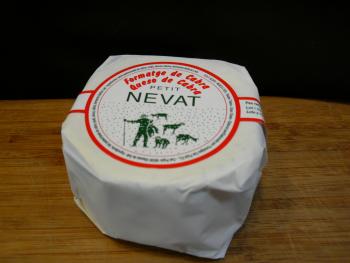Nevat / Petit Nevat
- Producer
- Josep Cuixart
- Country
- Spain
- Region
- Catalonia
- Size
- Varies
- Weight
- 5 lbs & 8oz
- Website
- Milk
- Goat
- Classification
- Soft
- Rennet
- Vegetable
- Rind
- Mold Ripened

Josep Cuixart, an esteemed Spanish cheesemaker, began Formatges Can Pujol in 1980. With milk from his small herd of goats he produced fresh, ready to eat cheeses at a small factory. However, by 1990, the business had expanded to the point that he was ready to move to a larger location, where the business remained for seven years. Soon after the move, Josep began producing aged cheeses starting with what would become his signature cheeses, Nevat. Now located in the village Vilassar de Dalt, north of Barcelona in Cataluña, Spain, Josep has developed a reputation for excellent cheeses including Nevat and Ros. Formatges Can Pujol still uses the milk from their own herd of goats, but also buy milk from neighboring farmers in their area in order to keep up with demand. Nevat is produced using the milk of Murcia and Grenadine goats that browse the classic Mediterranean, scrubby vegetation in the region of Vilassar de Dalt (15kms. north of Barcelona) near the sea coast. Their milk is particularly high in fat and consequently has the capacity to retain the flavors of thyme, rosemary and olive that comprise a large part of the goats' diet. These flavors then transfer into the cheese, even though the milk is pasteurized. The name "Nevat" translates to "snowy" in Catalan, and makes reference to the white, bloomy mold that develops on the surface rind of the cheese. Larger cheeses have a distinctive shape, which is that of a peaked mountain. This is due to the production process, when the curds are scooped up in a square of cheesecloth and left to drain. As the curds dry, they take on the imprint and shape of the cloth, which remains after they are turned out. Smaller versions of Nevat are made in a small disc shape. In mature cheeses the interior paste and texture of Nevat will remain bone-white and become soft, verging on runny, towards the rind, while remaining fairly firm in the center - especially with the large format. The rind occasionally picks up gray, or slightly red sticky patches which, again, is a sign of age. Younger cheeses are just as white (usually minus the patches) and have a more uniform firm texture.
Tasting Notes
Flavors are clean, milky and bright, with a citrus tang and an underlying sweetness that makes this cheese very accessible. Slight hints of salt balance everything out and give the cheese a pleasingly long finish.



